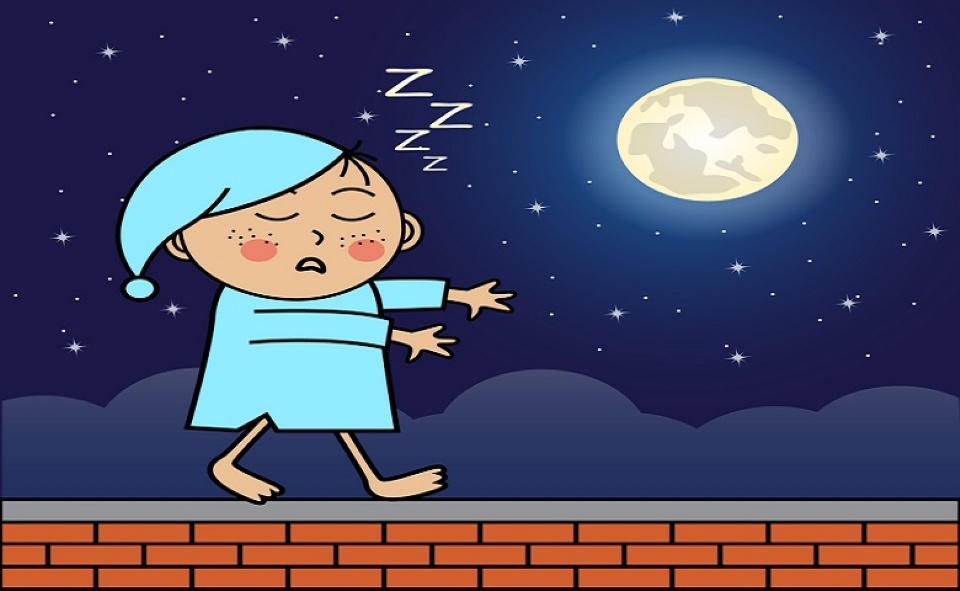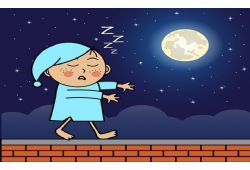You
already found your child standing up, asleep, while he should have been in bed?
Is he sleepwalking? Why? Is it dangerous?
If we wrote every
strange or funny story that many of you have to tell, we could write a full
book!Sleepwalking is
very common in children; 40<>percentage<> of children aged 6 to 16 years old – especially
boys – already experienced occasional episodes of sleepwalking while only 2 to
3<>percentage<> experience more than one episode every month.
What is sleepwalking?
It is a neurological
sleep disorder. The system that triggers the natural muscular paralysis during
sleep is maladjusted in sleepwalkers and that is why a noise or a need to go to
the toilet, for example, would awaken the body, but not the brain.
There are three
types of somnambulism. In simple somnambulism, the child sits
on his bed and performs clumsy gestures and can even talk. Sometimes, he also
gets up, walks around the house and goes back to bed.
We call somnambulism
at risk, the cases where episodes last more than ten minutes and occur two
or three times a week. The actions are often dangerous (he can use a dangerous
object or fall down the stairs for example).
Terror
somnambulism generally occurs in children before the age of six or after
the age of ten. Crises occur soon after the child falls asleep and he may
become very aggressive if we try to wake him up. He is unconscious and he will
run around the house, screaming, but will have forgotten everything as he
awakes.
How can I identify a
sleepwalker?
When they sit in
their bed, they walk around the house or even go outside, sleepwalkers seem
awake and open their eyes. They can answer questions by yes or no and can
perform elaborated actions like going downstairs, avoiding furniture or looking
in a cupboard. They can even execute orders but it doesn’t mean that we can
manipulate them at will. It is quite the opposite actually because a person who
is in the middle of a sleepwalking episode quickly becomes very irritable.
- These episodes usually occur during the first third of the night, during the deep sleep phase.
- The child (or the adult) does not dream; the brain activity is more similar to that of an awaken person than that of a sleeping person.
- How to react? The best thing to do is to gently escort your child back to his bed.
Stress, tensions, lack of sleep and migraines can cause episodes of somnambulism but also some diseases such as Tourette’s syndrome.
In adults prescription drugs, alcohol and drugs can also be a cause.
Notable fact; for 60 <>percentage<> of sleepwalkers, we noted other cases of that sleep disorder in the immediate or extended family or in previous generations.
Is sleepwalking dangerous?
Somnambulism itself is not dangerous but performing actions or making movements unconsciously can certainly become dangerous.
Contrary to popular belief, waking a sleepwalker is not dangerous. In fact, the reason why we should not wake them is because he could react abruptly or become aggressive. Also, believing that he had a nightmare, the child can run away, trip over something and hurt himself badly.
Can sleepwalking be cured?
Somnambulism in children generally disappears during puberty. In simple cases – sleepwalkers who have occasional episodes – we can try to eliminate the causes, for example by resolving the lack of sleep, reducing the child’s stress and avoiding violent exercises in the evening.
For children who have frequent somnambulism episodes, the doctor can prescribe medication to eliminate the phases of deep sleep. However, the effectiveness of the medication can fade after a while.
Doctors sometimes use hypnosis, which is relatively efficient.
To read more articles from Motherforlife website, please visit Motherforlife.com

 In The Latest Issue:
In The Latest Issue:


 BY:
BY: 

Tweet
Share